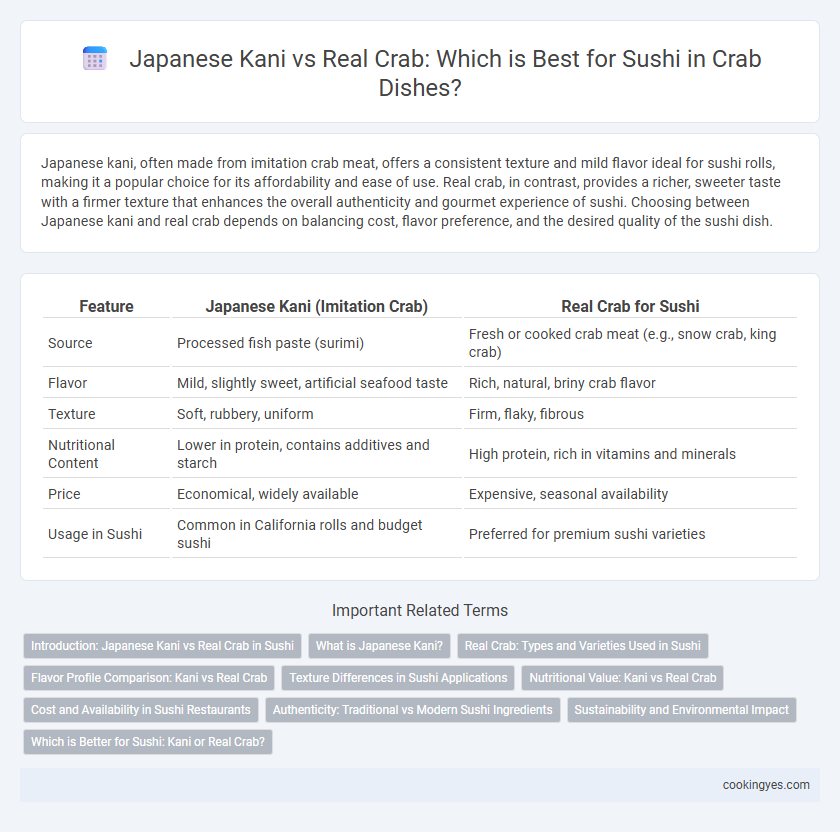Japanese kani, often made from imitation crab meat, offers a consistent texture and mild flavor ideal for sushi rolls, making it a popular choice for its affordability and ease of use. Real crab, in contrast, provides a richer, sweeter taste with a firmer texture that enhances the overall authenticity and gourmet experience of sushi. Choosing between Japanese kani and real crab depends on balancing cost, flavor preference, and the desired quality of the sushi dish.
Table of Comparison
| Feature | Japanese Kani (Imitation Crab) | Real Crab for Sushi |
|---|---|---|
| Source | Processed fish paste (surimi) | Fresh or cooked crab meat (e.g., snow crab, king crab) |
| Flavor | Mild, slightly sweet, artificial seafood taste | Rich, natural, briny crab flavor |
| Texture | Soft, rubbery, uniform | Firm, flaky, fibrous |
| Nutritional Content | Lower in protein, contains additives and starch | High protein, rich in vitamins and minerals |
| Price | Economical, widely available | Expensive, seasonal availability |
| Usage in Sushi | Common in California rolls and budget sushi | Preferred for premium sushi varieties |
Introduction: Japanese Kani vs Real Crab in Sushi
Japanese kani, often made from imitation crab meat called surimi, is processed from white fish and shaped to resemble real crab legs. Real crab used in sushi, such as snow crab or king crab, offers a distinct, sweet flavor and firm texture that imitation kani cannot fully replicate. Sushi chefs value authentic crab for its superior taste and quality, enhancing the overall dining experience.
What is Japanese Kani?
Japanese kani refers to imitation crab meat made primarily from surimi, a paste of white fish like pollock, flavored and colored to resemble real crab. It is commonly used in sushi rolls such as California rolls due to its affordability, mild taste, and consistent texture. Unlike real crab, kani lacks natural crab's complex flavor and delicate texture but offers a versatile and cost-effective alternative in Japanese cuisine.
Real Crab: Types and Varieties Used in Sushi
Real crab used in sushi primarily includes varieties like snow crab (zuwaigani), king crab (tarabagani), and blue crab (goshogani), prized for their sweet, delicate flavor and firm texture. Snow crab is favored for its tender meat and subtle sweetness, while king crab offers a more robust, rich taste with large, meaty legs ideal for sashimi and nigiri. Blue crab, although less common, provides a distinct flavor and is often sourced fresh from coastal waters, enhancing the authenticity and quality of sushi dishes.
Flavor Profile Comparison: Kani vs Real Crab
Japanese kani, often made from surimi or imitation crab, offers a mild, slightly sweet flavor with a rubbery texture that contrasts sharply with the delicate, naturally briny taste of real crab meat. Real crab delivers a complex umami profile, rich in oceanic sweetness and tender, flaky meat that enhances sushi's depth and authenticity. The nuanced flavor and texture of genuine crab elevate sushi experiences, making it a preferred choice for connoisseurs seeking true seafood quality.
Texture Differences in Sushi Applications
Japanese kani, often made from processed white fish like surimi, features a soft, pliable texture that blends smoothly with sushi rice, ideal for rolls and nigiri. Real crab meat, such as snow crab or king crab, displays a firmer, flaky texture that provides a distinct bite and a more pronounced oceanic flavor, elevating premium sushi dishes. The contrasting textures affect sushi applications by offering either the delicate ease of kani or the robust, natural mouthfeel of authentic crab, catering to varied consumer preferences.
Nutritional Value: Kani vs Real Crab
Real crab offers a rich nutritional profile with high protein content, omega-3 fatty acids, and essential minerals such as zinc and selenium, supporting muscle health and immune function. Japanese kani, often made from processed fish surimi, provides lower protein levels and fewer micronutrients compared to real crab, making it less nutrient-dense. For sushi enthusiasts seeking optimal nutrition, real crab delivers superior health benefits with its natural vitamins and minerals.
Cost and Availability in Sushi Restaurants
Japanese kani, often made from processed white fish called surimi, is significantly cheaper and more widely available in sushi restaurants compared to real crab, which commands a higher price due to its premium quality and limited supply. Real crab, sourced primarily from regions like Hokkaido, is seasonal and requires specialized handling, making it less accessible and more costly for sushi establishments. Sushi restaurants tend to use kani for affordable menu options, while real crab is reserved for high-end dishes that emphasize authentic seafood experience.
Authenticity: Traditional vs Modern Sushi Ingredients
Japanese kani used in sushi often consists of imitation crab made from processed white fish such as surimi, valued for its consistent texture and mild flavor in modern sushi preparation. Real crab, like snow crab or king crab, offers authentic taste and natural sweetness that traditional sushi enthusiasts prefer for genuine seafood experience. The choice between kani and real crab reflects a balance between convenience and culinary authenticity in Japanese cuisine.
Sustainability and Environmental Impact
Japanese kani commonly refers to imitation crab made from processed fish like pollock, offering a more sustainable seafood option compared to real crab, which faces overfishing and habitat degradation. Real crabs, especially species like blue crab and snow crab, are often subject to intensive fishing practices that impact marine ecosystems and contribute to population declines. Choosing kani reduces pressure on wild crab populations and supports environmentally responsible sushi consumption by lowering carbon footprints and minimizing bycatch.
Which is Better for Sushi: Kani or Real Crab?
Real crab offers a superior taste and texture for sushi, with natural sweetness and tender meat that enhances nigiri and rolls. Japanese kani, often made from imitation crab or surimi, provides affordability and convenience but lacks the authentic flavor profile of genuine crab meat. For sushi enthusiasts seeking an authentic experience, real crab is the preferred choice due to its richness and freshness.
Japanese kani vs real crab for sushi Infographic

 cookingyes.com
cookingyes.com